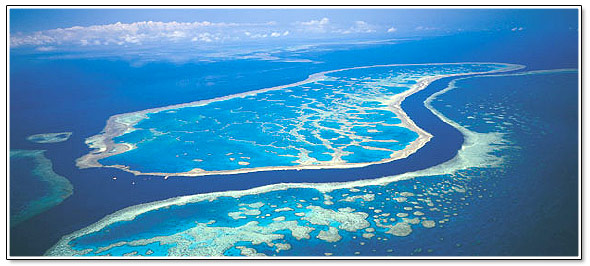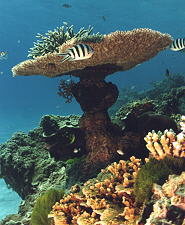
General information.
The Great Barrier Reef is the largest coral reef in the world, roughly parallel to the coast of Queensland, Australia. Australia has almost one fifth of the worlds reef area.
The reef is scattered with beautiful islands and idyllic coral cays and covers more than 300,000 square kilometres. The Great Barrier Reef system consists of more than 3000 reefs which range in size from 1 hectare to over 10,000 hectares in area. Dunk Island is one of more than 600 islands of the Great Barrier Reef.

Geographical processes that formed and transformed the Great Barrier Reef.
At least 350 species of coral are responsible for the construction of the Great Barrier Reef. Corals are biologically simple animals that belong to the same animal group. Living corals have a soft tubular body which is attatched to a surface at its base and is topped by a mouth and ring of tenticles that snare food. Although many types of coral may live in a coral reef, not all are reef builders.
Some corals live in large colonies and lay down a communal skeleton of calcium carbonate, which is also known as limestone. Where large numbers of these stony corals live together, their combined skeletons begin to build a coral reef. Over time, sand and rubble fill gaps between the skeletons of various colonies, cementing them together and forming a solid limestone foundation. The coral reef begins to grow. Other animals, and even plants, also contribute to the formation of the reef. Giant clams and other mollusks, for example, add their own calcium-carbonate shells to the reef structure. Coral reefs grow layer by layer over thousands of years.

The stony corals that build coral reefs are slow-growing but long-lived corals. Many types of stony corals grow in the Great Barrier Reef. However, corals are marine creatures and cannot grow above the water’s surface; exposure to air and rain, or other fresh water, can kill them.
Some parts of the Great Barrier Reef began to grow more than 2 million years ago, but most of the reef began to develop about 500,000 years ago.
Tourism.
Each year, more than two million people bisit the Great Barrier Reef, generating more than $AU2 billion in tourism dollars.Tourists are carried to the reef system by more than 500 commercial vessels, and tourism is permitted through nearly all the Park.
Most of the Reef is part of the Great Barrier Reef Marine Park and various parts of it are protected in certain ways. For example, fishing is restricted in some areas and some particular animals such as whales, dolphins, green turtles and dugong - are protected.
Tourism may also have a negative impacts. Some examples of this are: having fragile corals broken by reef walking, dropped anchors or by boats dropping fuel and other sorts of pollution into the water. Another major impct is the number of people in the water who are associated with run-off sweat, sun tan lotions and oils may well have a negative impact on the fragile reef environment.
Before visiting the Great Barrier Reef Marine Park, it is important you study the zoning map for the area you are visiting to be sure of the activities that you can do and where you can do them.
Climate .
The Great Barrier Reef has a tropical climate, with average temperatures in summer of between 24 and 33 degrees Celsius, in winter 14 to 26 degrees. Being a wet tropic climate, there are only 2 seasons, 'the green' and 'the dry'. The green season stretches from the first of the monsoonal rains (75% to 90% of the region's rainfall falls in the green season), usually in November, and ends in May. The region averages over 300 days of sunshine per year. The water is warm enough to swim in all year round.

Great Barrier Reef marine life.
Coral reefs provide the ideal conditions for marine life. They are found in shallow tropical waters that stay warm all year round. Their exposure to sunlight provides energy to the algae and plants that feed animals living in the reef. The reef itself provides creatures with a large, intricate surface area on which they can find food and shelter. For these reasons, more animal species are found on coral reefs than in any other marine ecosystem. The Great Barrier Reef has tremendous numbers of plants and animals.
The Great Barrier Reef possesses an abundance of coral types. Their variety creates a magnificent display of different shapes, sizes and colours. About 350 species of stony corals have been scientifically identified in the Great Barrier Reef.
About 1,500 species of fish are found in and around the Great Barrier Reef. Common in all areas are the gobies, which are the smallest fish on the reef. Some of the reef’s dwarf gobies are fully grown at 2.5 cm. Several types of shark are regular reef inhabitants, including silvertip, blacktip, and whitetip sharks. Visiting sharks include hammerheads and the whale shark, the reef’s largest fish at up to 12 m in length. Along with sharks, groupers are among the most important predators of the reef. Many groupers are quite small, but the giant, or Queensland, grouper is known to reach a length of 2.7 m and a weight of more than 400 kg. The butterfly fish is one of the most colorful reef dwellers, with 45 different types known to live in the Great Barrier Reef, including some that eat coral.
Other plant and animal life in the reef includes 500 kinds of algae, 4000 types of mollusks, and 20 species of sea snakes. The Great Barrier Reef Marine Park is an important refuge for a number of threatened species, including 30 species of whales and dolphins, 6 species of sea turtles, the dugong which is a sea coe and also giant clams.
Environmental issues .
Nearly 60 percent of the world’s coral reefs are classified as threatened. The reefs of Australia are ranked as some of the least threatened, with only 30 percent classified as at risk, and only 1 percent at high risk. However, the Great Barrier Reef is a delicately balanced ecosystem that is susceptible to damage.
Since 1962 scientists have observed periodic population explosions of the crown-of-thorns starfish on the Great Barrier Reef. This giant starfish is a predator of corals, feeding on the polyps. Plagues of these starfish can destroy all of the corals on individual reefs. Reefs can recover, but it takes years or even decades. Scientists suspect that human activities contribute to the population explosions of the starfish. For example, fishing reduces the number of starfish predators. In addition, freshwater runoff from land into coastal waters often contains fertilizers and other nutrients that enable starfish larvae to survive in greater numbers.
Coral bleaching may be one of the greatest threats to the Great Barrier Reef. Coral bleaching is a stress response that often occurs when the surrounding waters become too warm for the corals. In the stressful situation, the corals expel their brownish zooxanthellae and lose their color. Without the zooxanthellae, the coral cannot obtain sufficient nourishment. If conditions remain difficult, the corals may die. Major coral bleaching incidents on the Great Barrier Reef in 1998 and 2002 led to widespread death of corals in some areas.
Concideration efforts.
The state government of Queensland is responsible for enforcing federal and state laws that can help protect the Great Barrier Reef, such as the Environmental Protection Act and the Marine Parks Act. The state government and the marine park authority often work together to address reef-conservation issues. They collaborate on education and research efforts, particularly in relation to land-use planning and site management. For example, they have coordinated their efforts to involve landowners and others in reducing runoff from rivers and other watersheds that carry pollutants and sediments from land into the marine park.
